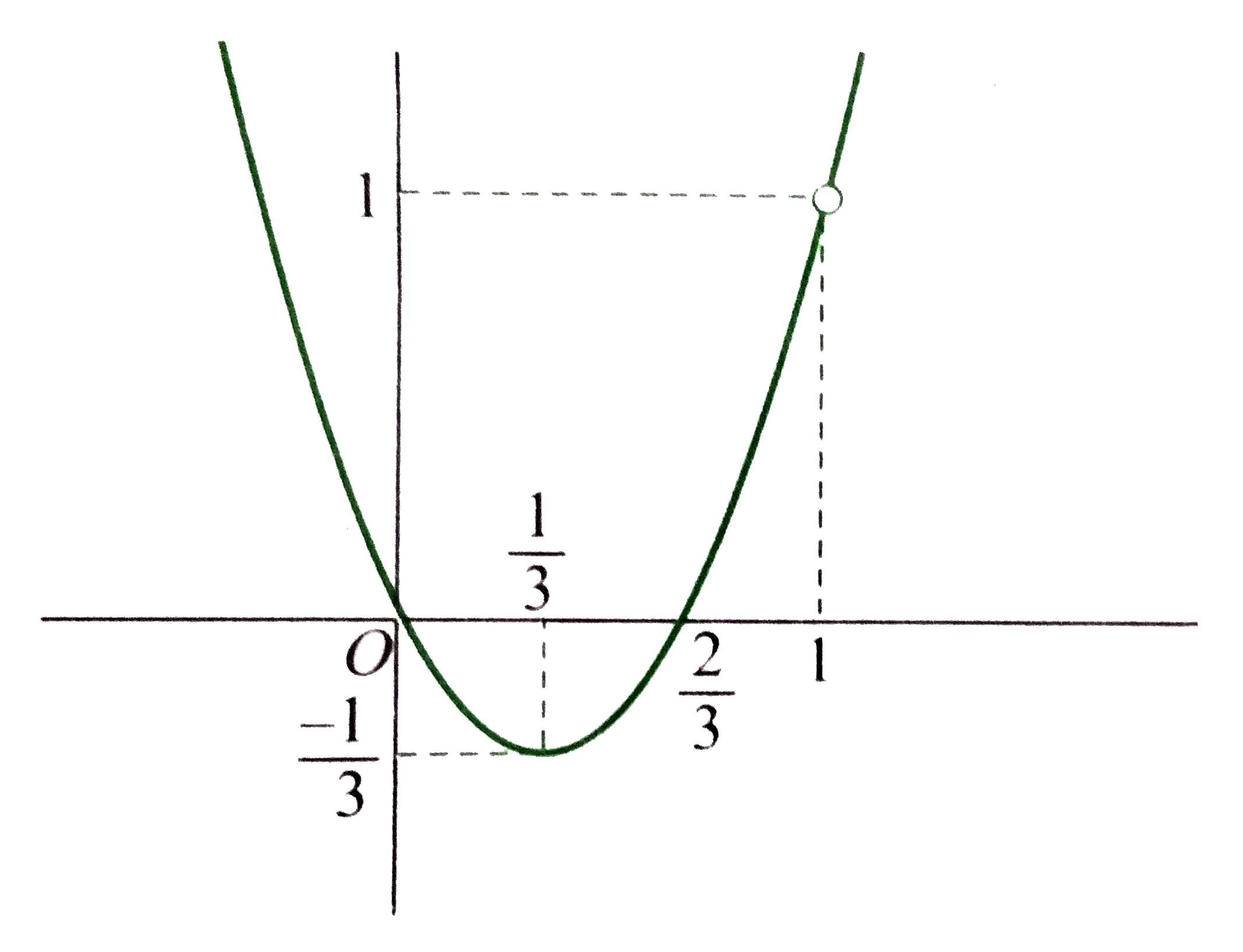If a∈R and the equation −3(x−[x])2+2(x−[x])+a2=0 (where [x] denotes the greatest integer ≤x) has no integral solution, then all possible values of a lie in the interval: (1) (-2,-1) (2) (∞,−2)∪(2,∞) (3) (−1,0)∪(0,1) (4) (1,2)Solution in Tamil
(−1,0)∪(0,1)
(1,2)
(−2,−1)
(−∞,−2)∪(2,∞)
The correct Answer is:A
a2=3t2−2t, where t={x}∈[0,1)
∴a2=3t(t−2/3)
Graph of f(t)=3t(t−2/3) is as shown in the following figure.

Clearly, from graph
0<a2<1
ora∈(−1,0)∪(0,1)
Topper's Solved these Questions
- RELATIONS AND FUNCTIONSBOOK - CENGAGECHAPTER - RELATIONS AND FUNCTIONSEXERCISE - Exercise (Numerical)
31 Videos
- Quadratic Equations, Inequalities, Modulus and LogarithmsBOOK - CENGAGECHAPTER - Quadratic Equations, Inequalities, Modulus and LogarithmsEXERCISE - Question Bank
28 Videos
- SCALER TRIPLE PRODUCTS BOOK - CENGAGECHAPTER - SCALER TRIPLE PRODUCTS EXERCISE - DPP 2.3
11 Videos
Similar Questions
Let f be a real-valued invertible function such that f(−32xx−2)=5x−2,x≠2. Then value of f−1(13) is________
View SolutionLet a,b,c,d be positive integers such that (log)ab=32and(log)cd=54. If (a−c)=9, then find the value of (b−d).
View SolutionNumber of integral value(s) of λ for which vectors x2ˆi−ˆj+xˆk,(λ−1)ˆi−2λˆj+ˆk and ˆi−ˆj+ˆk, in the order from right-handed system ∀x ∈R, is
View SolutionThe domain of the function f(x)=sin−1(3−x)In(|x|)−2 is
View Solutionf(x)=∣∣x2−3∣∣x|+2|. Then which of the following is/are true f′(x)=2x−3forx∈(0,1)∪(2,∞) f′(x)=2x+3forx∈(−∞,−2)∪(−1,0) f′(x)=−2x−3forx∈(−2,−1) noneofthese
View SolutionSolution set of the inequation, x2−5x+6x2+x+1<0 is x∈(−∞,2) (b) x∈(2,3) x∈(−∞,2)∪(3,∞) (d) x∈(3,∞)
View SolutionSolution set of the inequation x2+4x+42x2−x−1>0, is x∈(−∞,−2)∪(−2,1) x∈(−∞,−2)∪(−2,−12)∪(1,∞) x∈(−∞,−2)∪(−12,1)∪(1,∞) x∈(−∞,1)
View SolutionSolution set of inequality (ex−1)(2x−3)(x2+x+2)(sinx−2)(x+1)2x≤0 is [32,∞) b. (−∞,−1)∪[32,∞) c. [−1,0)∪[32,∞) d. R−{0,−1}
View SolutionThe intervals of increase of f(x) defined by f(x)=∫x−1(t2+2t)(t2−1)dt is equal to (−∞,−32)∪(0,3)∪(10,∞) (−∞, −2)∪(−12,12)∪(4,∞) (−∞, −2)∪(−1,0)∪(1,∞) (−∞, −2)∪(−34,14)∪(1,∞)
View SolutionDomain of definition of the function f(x)=(3)/(4-x^(2))+log_(10)(x^(3)-x) is (A) (-1,0)uu(1,2)uu(2,oo)(B)(-1,0)uu(1,2)uu(C)(1,2)(D)(1,2)uu(2,oo)
View SolutionThe domain of the function f(x)=√(x+1)(x−3)x−2 is [−1,2)∪[3,∞) b. (−1,2)∪[3,∞) c. [−1,2]∪[3,∞) d. none of these
View SolutionIf a ∈ R and the equation (a−2)(x−[x])2+2(x−[x])+a2=0 (where [x] denotes the greatest integer function) has no integral solution and has exactly one solution in (2, 3), then a lies in the interval
View SolutionIF ∈R and the equation −3(x−[x])+a2=0 ( where [x] denotes the greatest ineteger ≤x ) has no integral solution , then all possible values of a lie in the interval
View SolutionThe domain of the function f(x)=√log(|x|−1)(x2+4x+4) is (a) (−3,−1)∪(1,2) (b)(−2,−1)∪(2,∞) (c)(−∞,−3)∪(−2,−1)∪(2,∞) (d)none of these
View Solutionf(x)=∣∣x2−3∣∣x|+2|. Then which of the following is/are true f′(x)=2x−3 for x in (0,1)∪(2,∞)
f′(x)=2x+3 for x in (−∞,−2)∪(−1,0)
f′(x)=−2x−3 for x in (-2,-1)
None of these
View SolutionThe domain of the function f(x)=√(x+1)(x−3)x−2 is [−1,2)∪[3,∞) b. (−1,2)∪[3,∞) c. [−1,2]∪[3,∞) d. none of these
View Solution
